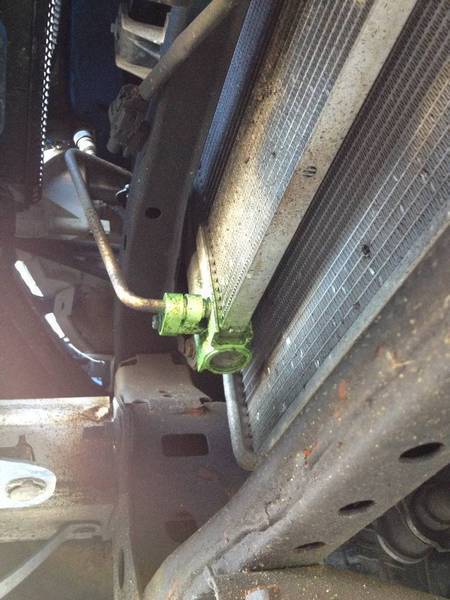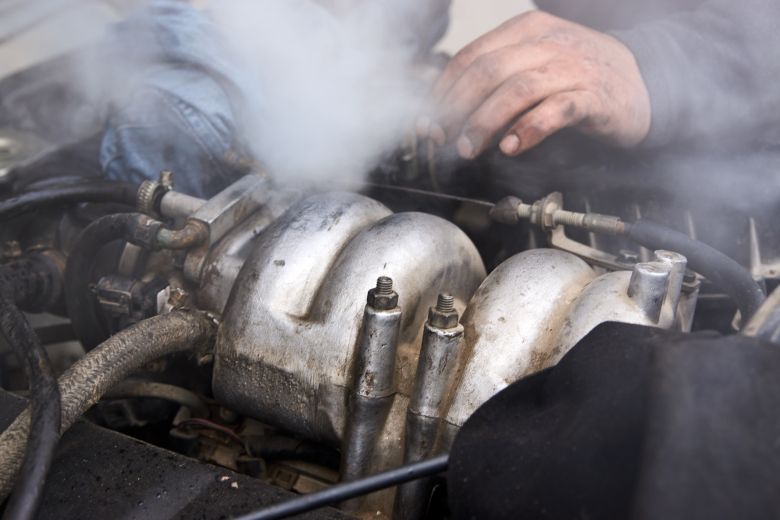What Color is Ac Fluid in Car
Automotive AC fluid, commonly referred to as refrigerant, is usually colorless. This fluid circulates within the AC system of a car.
Understanding the nature of automotive AC fluid is essential for vehicle maintenance and troubleshooting. The refrigerant, although clear, will often appear as a gas or a slight mist when leaking from the system due to its low boiling point. Maintaining the correct level of this specialized fluid is crucial for a car’s air conditioning to function effectively, providing comfort to passengers during the warmer months.
Regular system checks by a professional can preemptively address any potential issues, such as leaks or contamination, ensuring optimal performance of the air conditioning system. Proper AC maintenance can enhance both the longevity of the vehicle’s AC components and the overall driving experience.
The Mystery Of Ac Fluid Colors
Imagine peeking under your car and noticing a strange liquid pooling underneath. No need to panic! That liquid could be from your car’s air conditioning (AC) system. But what color is AC fluid, and why does it matter? Let’s unravel the mystery together and understand the colorful world of AC fluids.
Identifying Different Hues
Coolant, sometimes mistaken for AC fluid, often showcases vibrant shades. In contrast, pure AC refrigerant is colorless. However, AC systems don’t exist in a vacuum; they interact with oils and dyes that can influence the color of leaked fluids.
- Clear to Pale Yellow: A mix of refrigerant and AC compressor oil.
- Bright Green, Pink, or Fluorescent Yellow: These hues indicate the presence of a UV dye, added to help detect leaks.
The Role Of Dye In Leak Detection
Service technicians often introduce UV dye into the AC system for troubleshooting. Under UV light, this dye glows, revealing the location of leaks with stunning clarity. This approach streamlines maintenance by pinpointing problem areas with speed and accuracy.
| Dye Color | Usage |
|---|---|
| Bright Green | Most common for detecting AC leaks |
| Pink | Alternate option for UV dye |
| Fluorescent Yellow | Works well with different refrigerants |
The introduced dyes, safe for the AC system, mingle seamlessly with the refrigerant. This simple yet effective tactic ensures quick leak identification. So when odd-colored puddles appear, remember, they could just be a sign of your trusty mechanic’s detective work!
Ac Refrigerant: Color And Characteristics
AC Refrigerant: Color and Characteristics are crucial for maintaining your car’s cooling system. The refrigerant in a car’s AC system works like blood in the human body, necessary for cooling efficiency. Recognizing the refrigerant color can help in proper maintenance and leak detection.
The Nature Of Refrigerant
Refrigerant is the lifeblood of your car’s air conditioning system. It absorbs heat from the car’s cabin and releases it outside, keeping the interior cool. Quality and purity ensure the system’s longevity.
Common Colors In Various Refrigerant Types
- R-12: A clear, colorless gas once common but not used in newer cars.
- R-134a: Also colorless, made for newer models, commonly recognized.
- R-22: Colorless and older, not intended for automotive use, but still found in some vehicles.
- R-1234yf: The latest standard, a colorless new-generation refrigerant.
Manufacturers add small quantities of UV dye to refrigerants for easy leak detection, which can alter the refrigerant’s color when checking with a UV light source.
| Type | Color | Use |
|---|---|---|
| R-12 | Colorless | Old Vehicles |
| R-134a | Colorless | Newer Vehicles |
| R-22 | Colorless | Limited Use |
| R-1234yf | Colorless | Modern Cars |
Remember, the refrigerant itself should be nearly invisible. Any noticeable color could be from added dye. Color presence assists technicians in identifying and servicing AC systems efficiently.
Lubricants And Additives In The Ac System
If your car’s air conditioning (AC) isn’t cold enough, you might have a fluid issue. The AC system relies on special fluids to function. These fluids include lubricants and additives. They cool and lubricate the system. Let’s explore what these substances look like and their roles.
Compressor Oil And Its Appearance
Compressor oil is key in your car’s AC system. It keeps the compressor working smoothly. The color of this oil can tell us a lot. Typically, it’s a clear, light yellowish hue. Sometimes, it’s a little darker. But if you spot any funky colors or debris, that could signal trouble. It’s important to check this oil regularly to ensure your AC runs well.
Additives And Their Influence On Fluid Color
Additives enhance your AC system’s performance. They can change fluid colors, though. Dyes may turn fluids bright colors, like green or red. These colors help techs find leaks. Let’s go through the impacts:
- Leak detection dyes: These additives make spotting leaks easier, typically showing up under UV light.
- Performance enhancers: These can enhance efficiency and heat transfer, possibly altering fluid tint.
- Corrosion inhibitors: These help protect metal parts and may mix with the oil to change its appearance slightly.
Understanding the role of each additive can help maintain your AC system better. Regular checks ensure everything is in top shape.

Credit: www.tacomaworld.com
Leak Detection And Fluid Inspection
Cool air on a hot day is a car’s best gift in summer. But what happens when your car’s AC starts to fail? Oftentimes, the culprit is leaking AC fluid. Knowing what color your car’s AC fluid is can be the key to detection and quick repair. Let’s dive into the signs of AC fluid leaks and how to spot them efficiently.
Signs Of Ac Fluid Leaks
Spotting an AC fluid leak early can save your car from more damage. Here’s what to look for:
- Unusual stains underneath the car.
- AC not cooling as expected.
- Strange noises when the AC is on.
- Musty odors inside the car.
| AC Fluid Color | Meaning |
|---|---|
| Green/Yellow | Leak detection dye present |
| Clear | Possibly normal condensation water |
| Other Colors | Potential contaminants or issues |
Using Uv Light To Trace Leaks
UV light is a smart trick to catch sneaky leaks. Mechanics use a special dye and UV light for this. Here’s the step-by-step method:
- Add UV dye to the AC system.
- Let the car run and operate the AC.
- Inspect the car with a UV light.
- Look for bright spots that show leaks.
This approach pinpoints leaks that the naked eye can’t see. Regular fluid inspections ensure your AC works right and keeps you cool.
Maintaining Your Car’s Ac System
Maintaining Your Car’s AC System is crucial for enjoying cool air during hot days. A car’s AC system uses special fluid, often referred to as refrigerant, to cool the air. The color of AC fluid can vary, usually being a clear, slightly yellowish hue. Proper maintenance ensures this system works efficiently all year round. Let’s ensure your car’s AC is at its best with some simple tips.
Regular Check-ups For Optimal Performance
To keep your car’s AC in top shape, consider these points:
- Check refrigerant levels often to spot leaks early.
- Clean or replace air filters as needed.
- Inspect the AC compressor belt for wear and tear.
- Look for blockages in the condenser that might affect airflow.
- Use a thermometer to gauge the AC output temperature.
When To Seek Professional Help
If your car’s AC shows these signs, contact a professional:
| Sign | Action Needed |
|---|---|
| Odd smells | Clean or replace the cabin filter. |
| Weak airflow | Check for blockages or faulty fans. |
| Warm air | Recharge or repair the AC system. |
| Rattling noises | Inspect for loose components or debris. |
Remember, dealing with AC fluid requires special handling. Always rely on certified auto technicians to manage these issues safely.

Credit: www.myqualitytuneup.com
Debunking Myths About Ac Fluid Colors
Car AC systems are vital for comfort. But confusion about AC fluid colors often leads to myths. Understanding the true colors of AC fluids is key. Let’s dispel common misconceptions.
The Truth About Universal Fluid Colors
Many believe that AC fluid color is standard across cars. This is not always true. Various manufacturers might use different dyes in their refrigerants. The idea of universal fluid colors is a myth. It’s important to consult your car’s manual or a professional to know the exact color of your AC fluid.
| Brand | Common Fluid Color |
|---|---|
| Brand A | Green |
| Brand B | Blue |
| Brand C | Yellow |
Note: The above table illustrates potential variations. Always confirm with your specific car model.
How Color Can Mislead Diagnosis
Technicians might assume a leak based on fluid color. Yet, other issues might be present. Color alone should not dictate the diagnosis. Comprehensive system checks ensure accurate findings.
- Leaks: Require complete inspection, not just observing fluid color.
- Performance: Other signs like poor cooling deserve attention.
Remember, color isn’t an AC system’s tell-all sign. Only a thorough evaluation by an expert can pinpoint the true issues.

Credit: www.fleetmaintenance.com
Frequently Asked Questions For What Color Is Ac Fluid In Car
What Color Should My Car’s Ac Fluid Be?
Typically, car AC refrigerant is colorless. However, manufacturers sometimes add a UV dye. This dye helps in detecting leaks and can give the refrigerant a slight coloration, usually a light green or fluorescent yellow hue.
Can Ac Fluid Color Indicate Issues?
Yes, if the AC fluid has a dark or murky appearance, it might suggest contamination. Contamination occurs due to leaks, moisture entry, or system deterioration. It’s advisable to consult a mechanic for evaluation.
How Do I Check The Color Of Ac Fluid?
To inspect AC fluid color, use a UV light or rely on a mechanic’s assessment. Mechanics check during routine services or when diagnosing AC performance issues with specialized dye and detection equipment.
Will The Ac Fluid Color Change Over Time?
AC fluid might get slightly darker with age due to normal system use. Significant color changes, however, usually indicate a problem such as contamination or a refrigerant leak that requires professional attention.
Conclusion
Understanding your car’s AC fluid color is essential for vehicle maintenance. It’s a simple check that can reveal a lot about your system’s health. Remember, clear, pale yellow, or slightly greenish hints at normalcy, while other colors might signal a trip to the mechanic.
Stay observant and drive safely!





